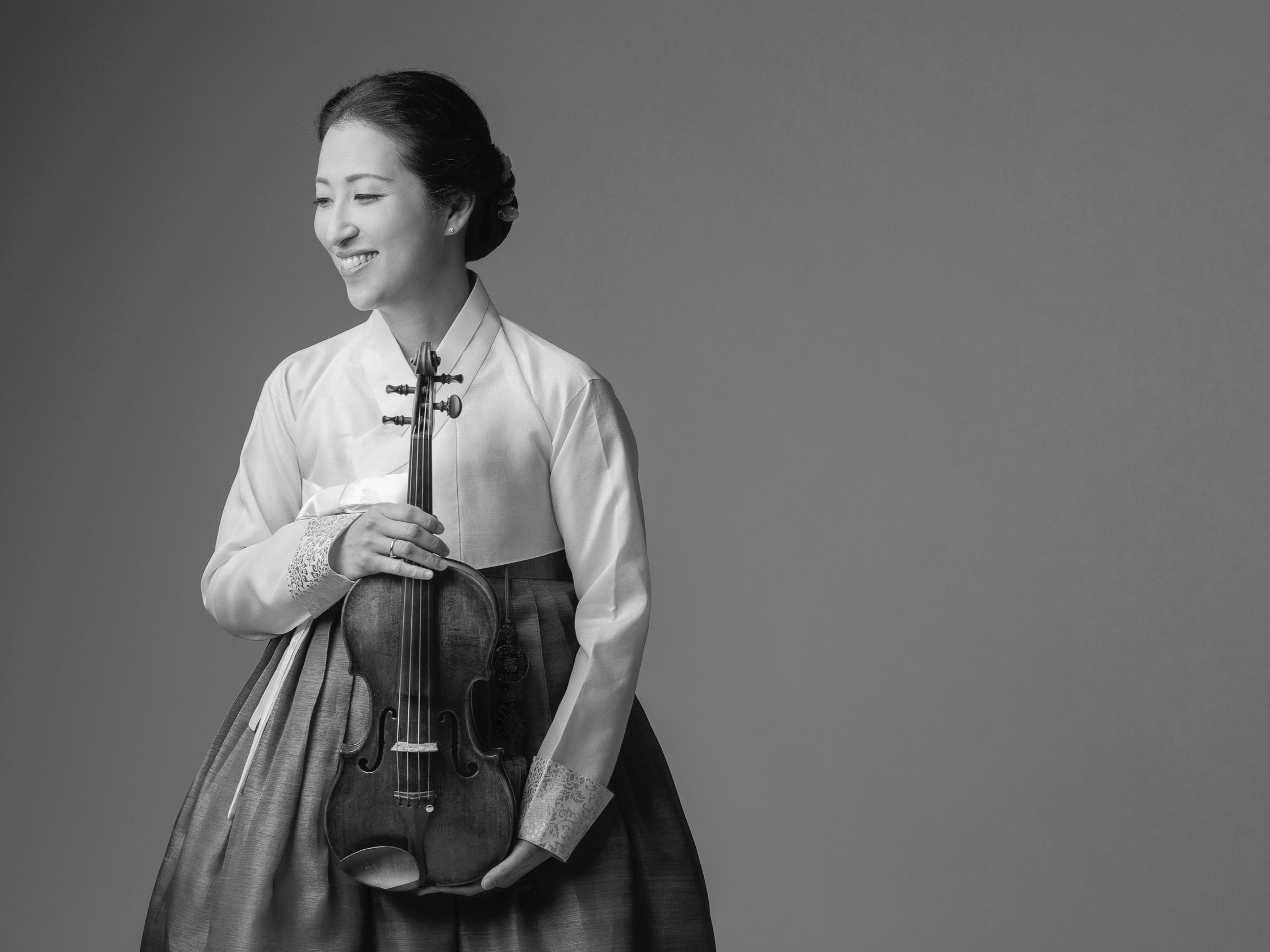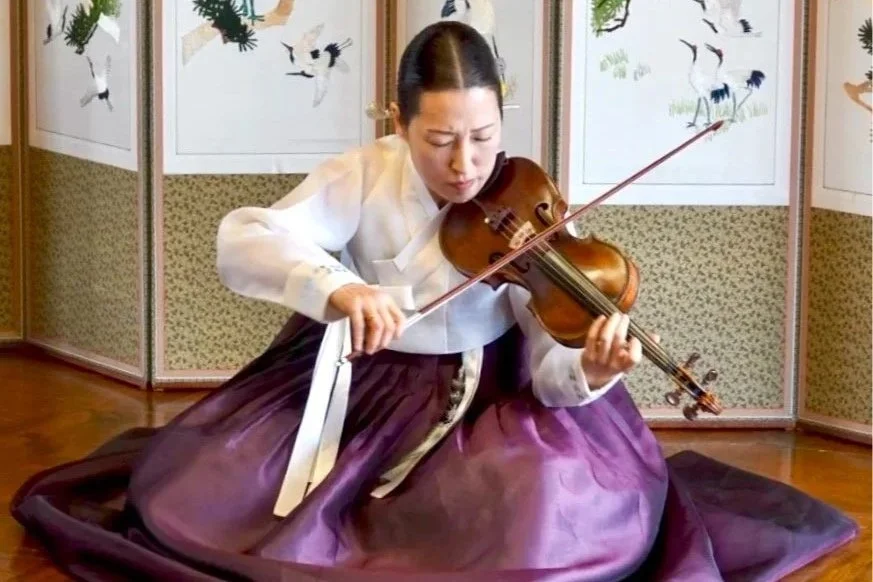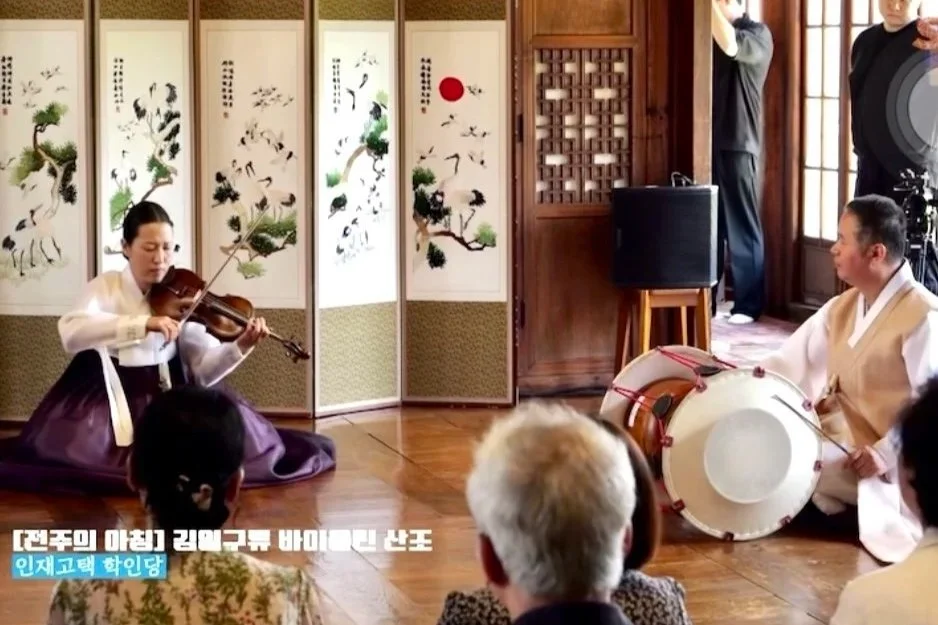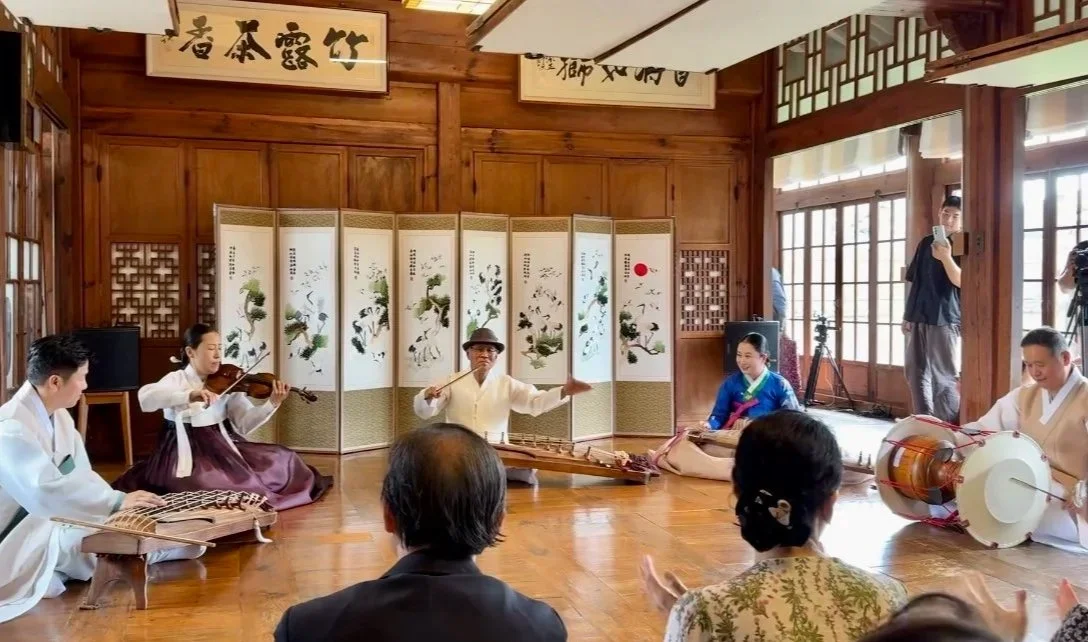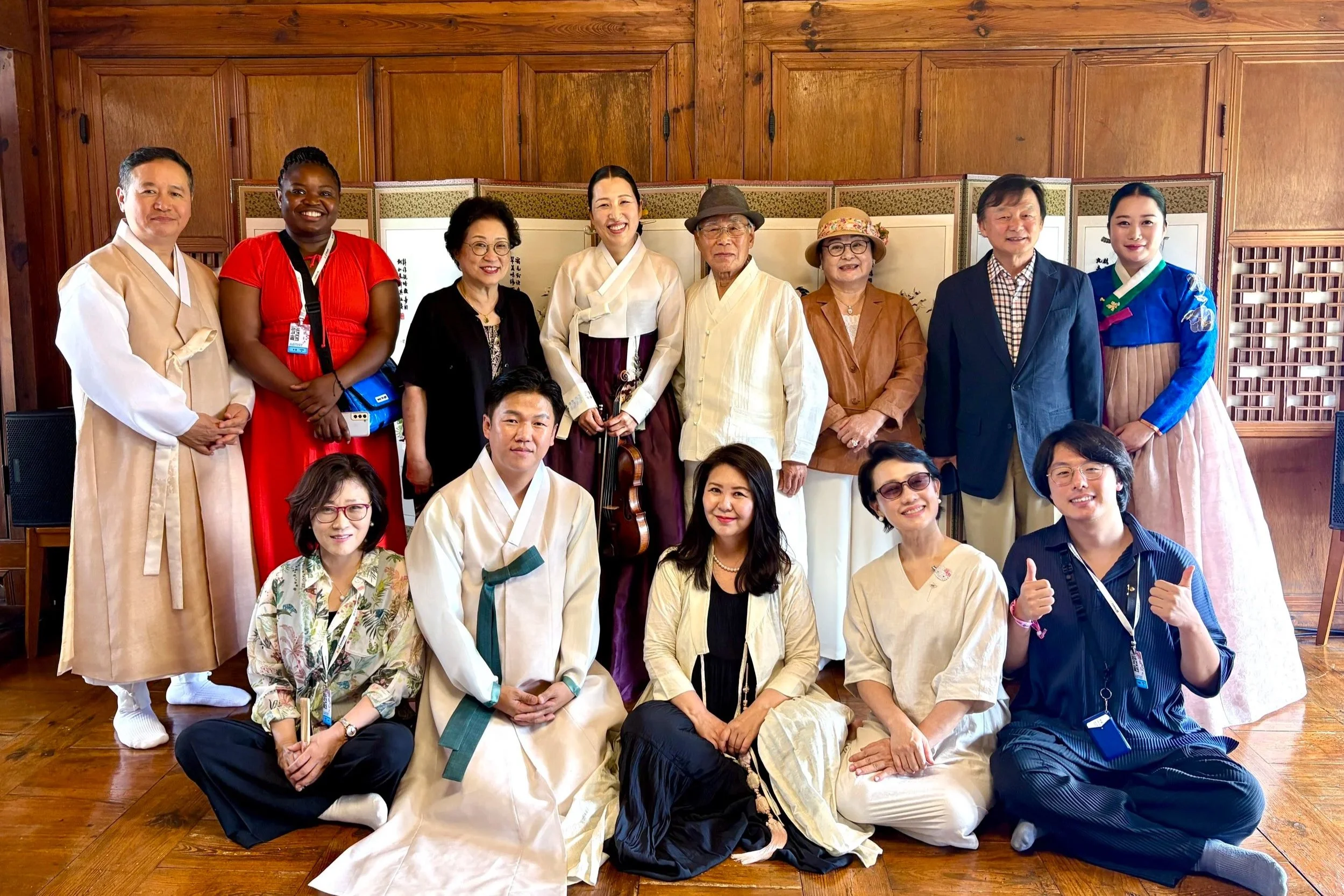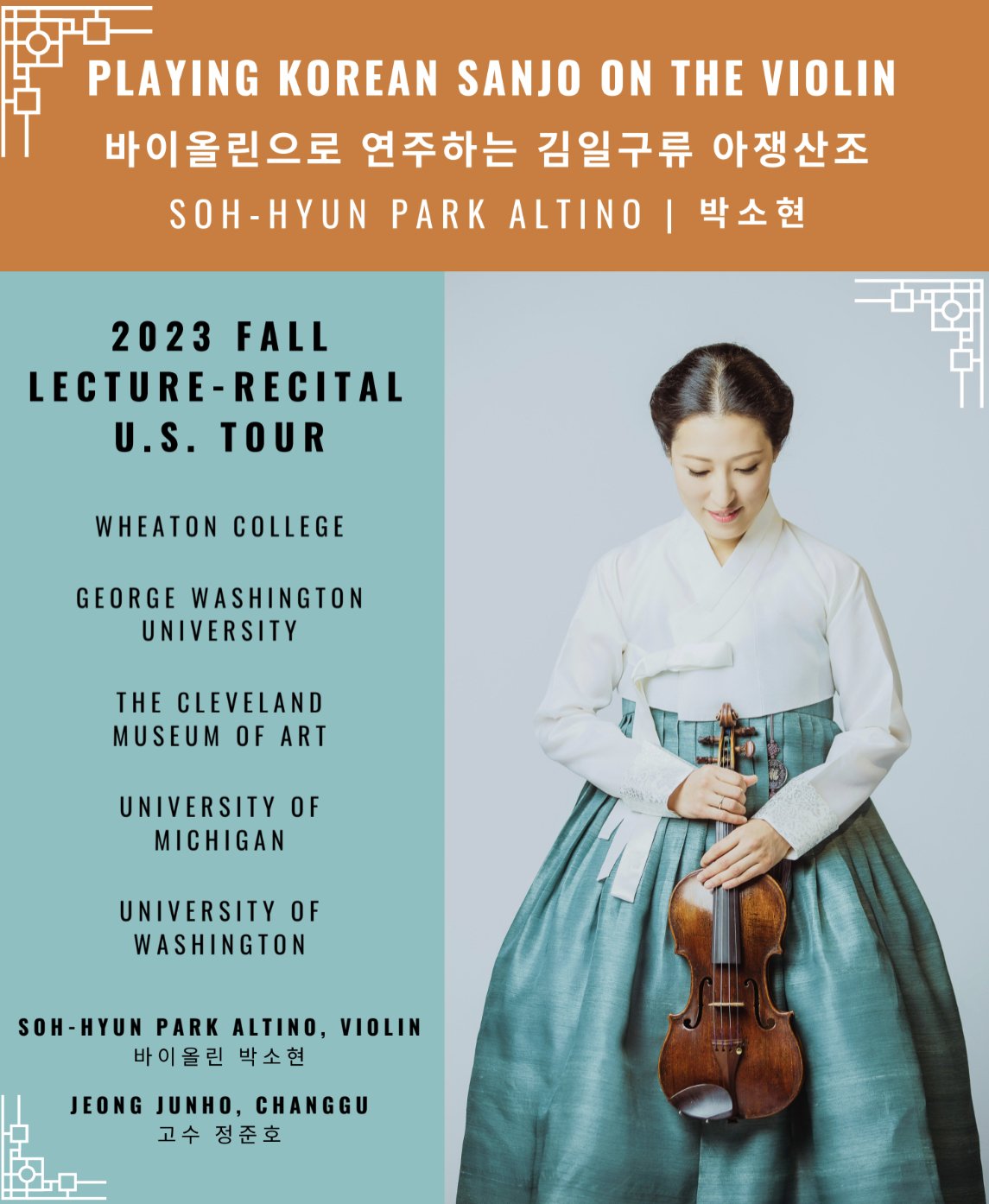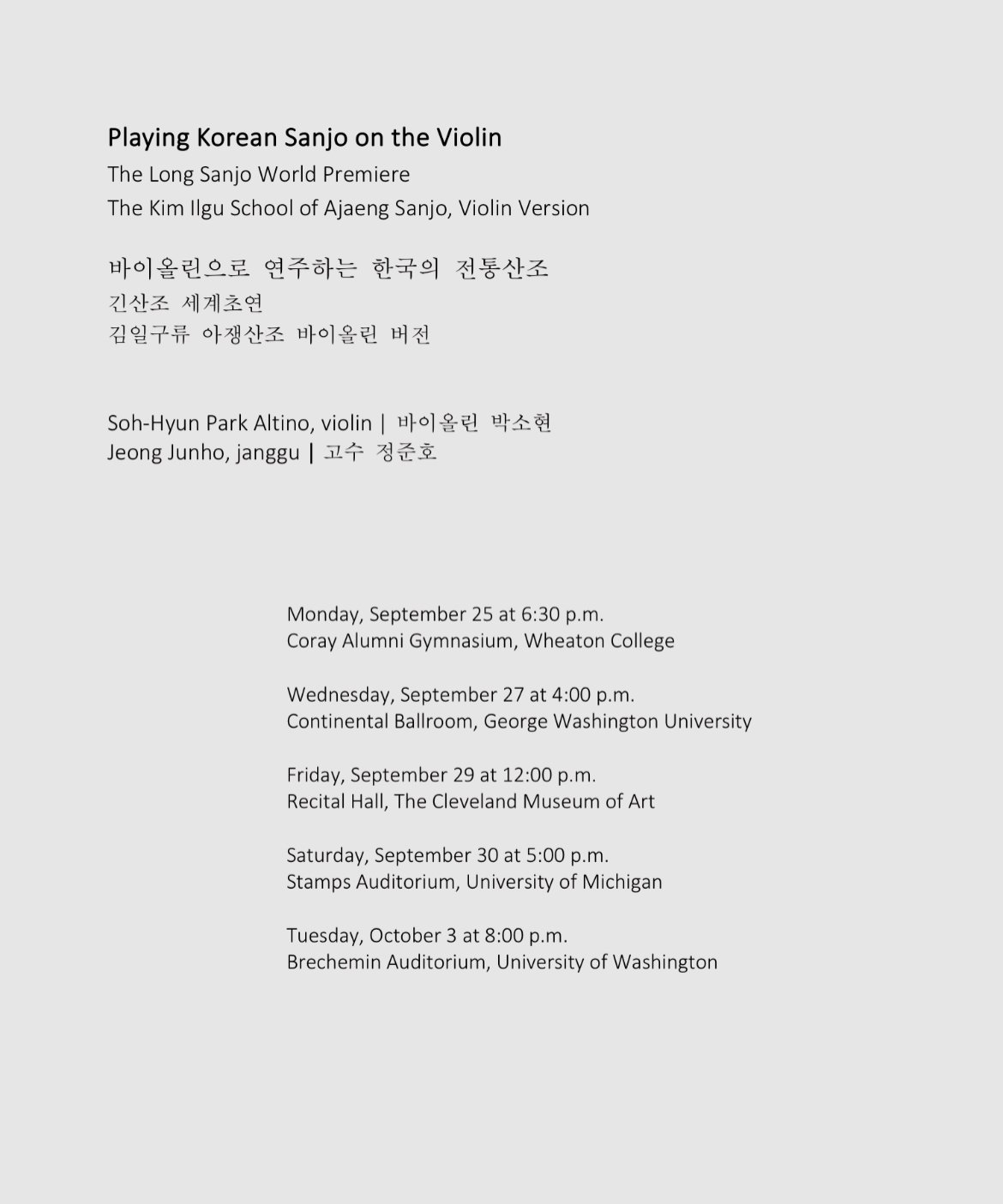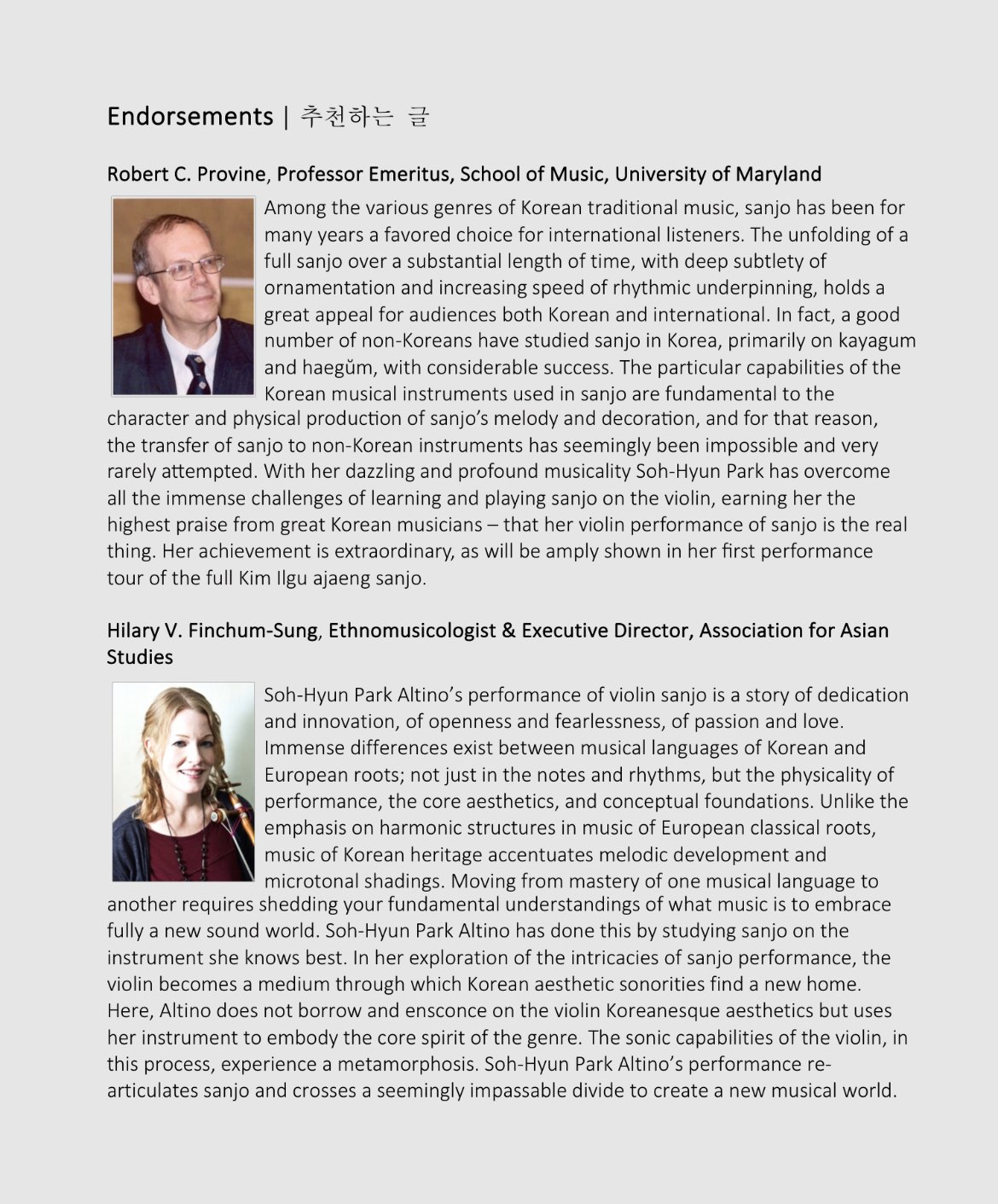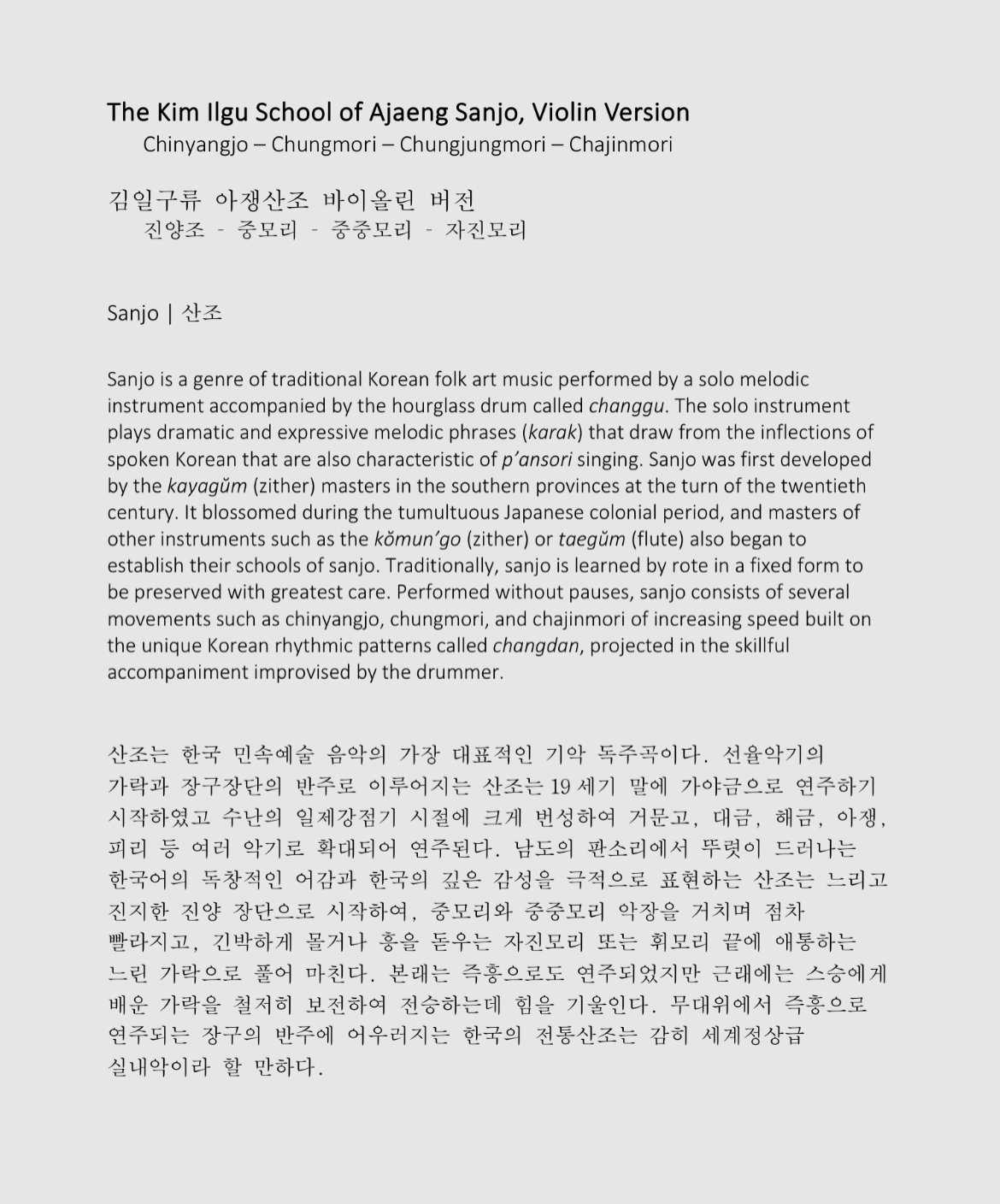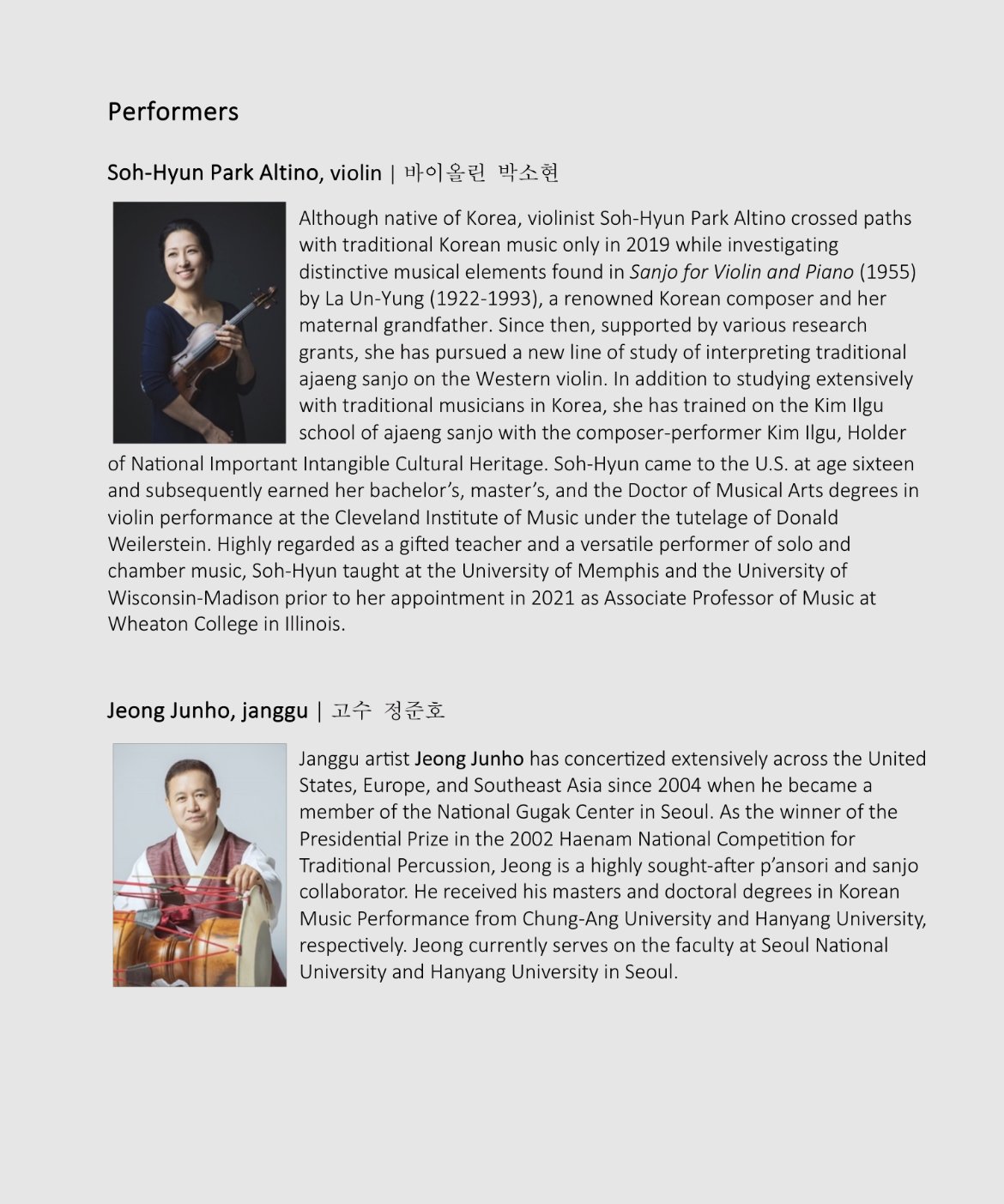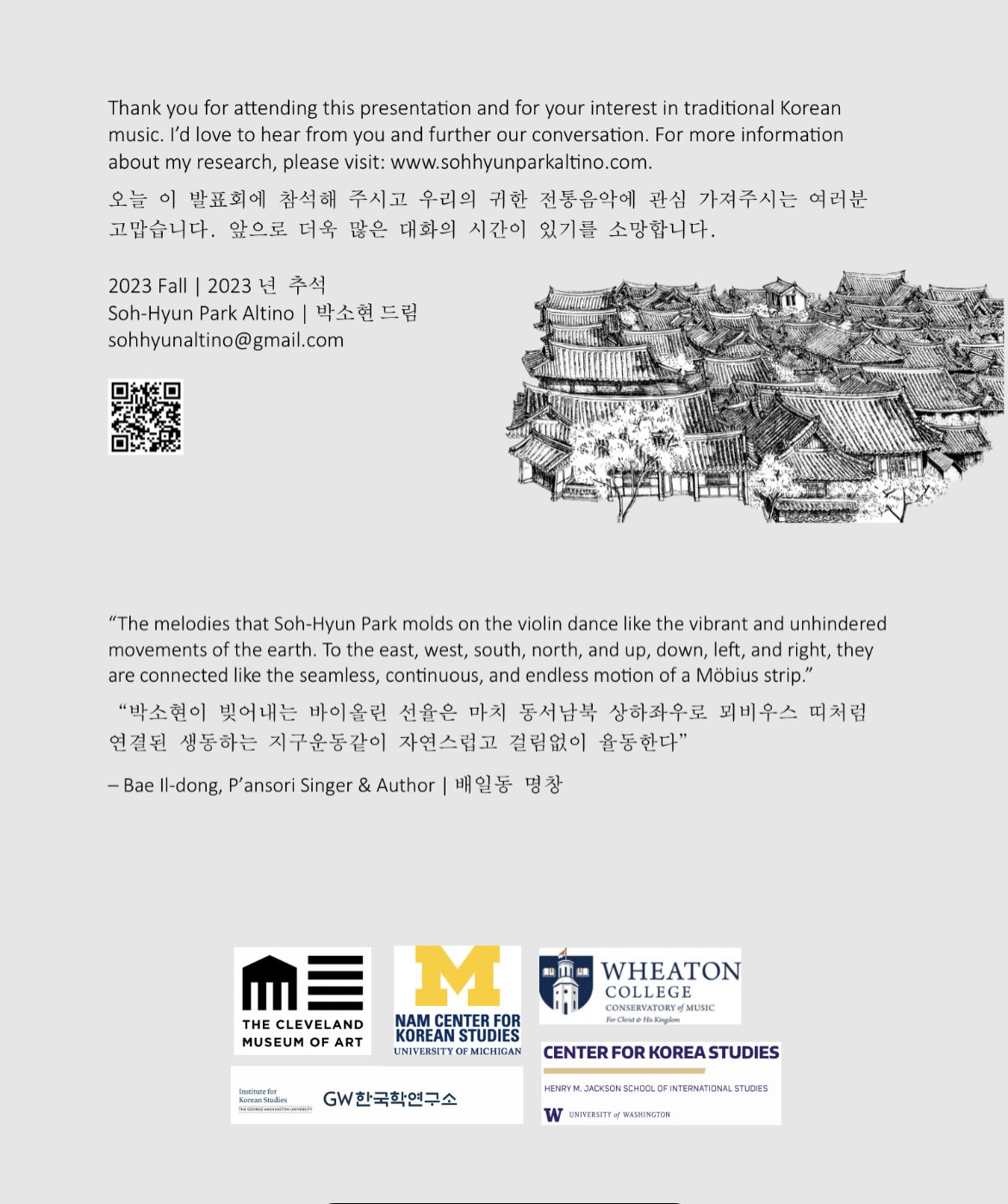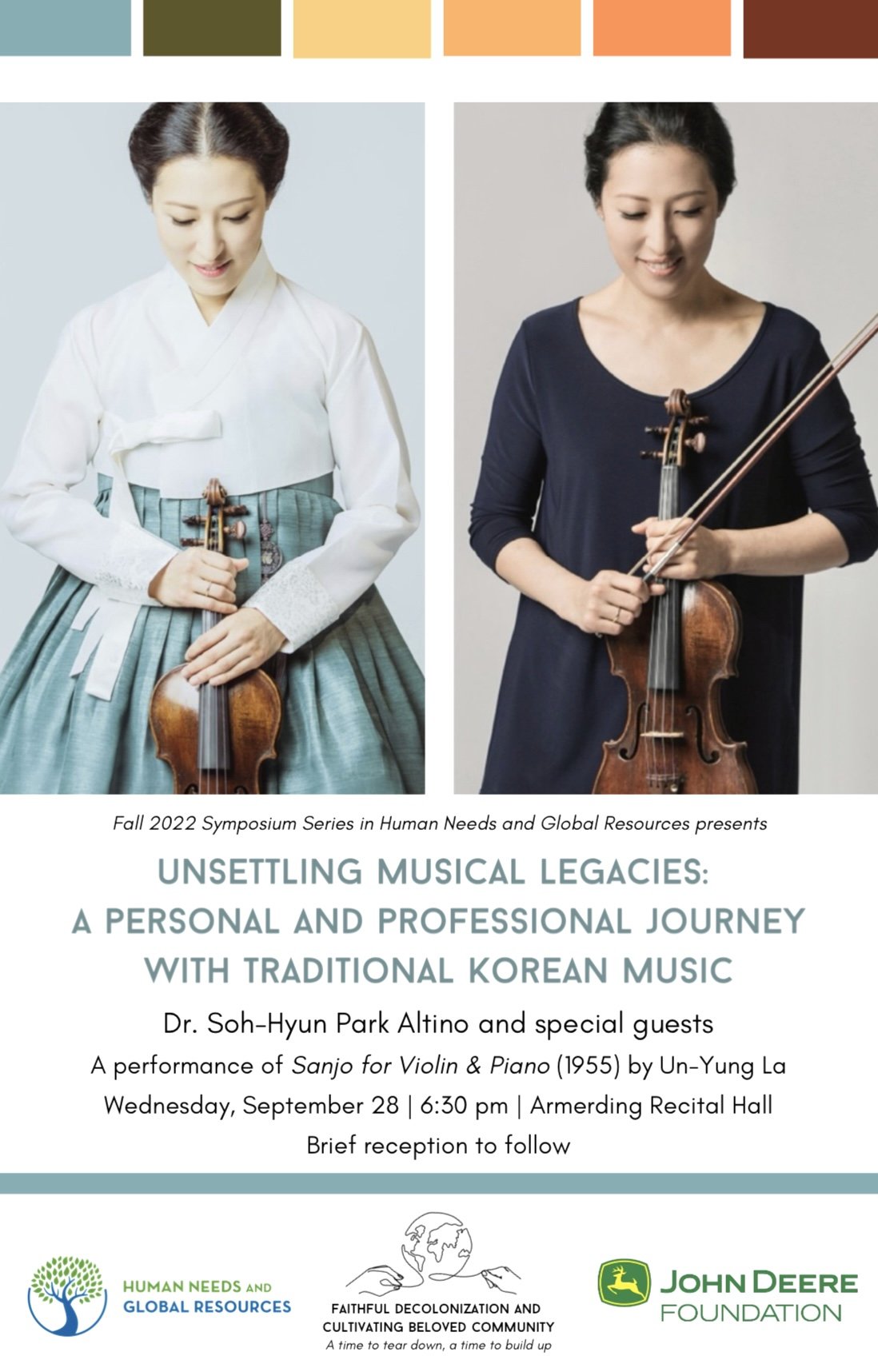Playing Korean Sanjo on the Violin.
“It’s certainly not something you hear everyday: a concert-lecture of Korean traditional music played on the modern violin. Can this kind of thing work? Should it? It turns out the answer to both questions is absolutely, yes. Born and raised in Korea… Soh-Hyun Park Altino was the perfect guide and persuader during her concert at The Cleveland Museum of Art on Friday afternoon, September 29.”
—Kevin McLaughlin, ClevelandClassical.com. October 5, 2023
*Sanjo is a genre of Korean traditional folk art music for a solo melodic instrument, accompanied by changgu, an hourglass drum.
August 15, 2025 @ 10:30 AM.
Hagindang, Jeonju Hanok Village.
24th Jeonju International Sori Festival.
Reviews.
Interviews.
Playing Sanjo on the Violin. The Story.
Although I was born and raised in Korea, traditional Korean music (Kugak or Gugak) and I did not cross paths until 2019 when I was trying to figure out how to play Sanjo for Violin and Piano (1955), a work by La Un-Yung (1922-1993), a renowned Korean composer and my maternal grandfather.
Prior to this time, I had had no meaningful exposure to kugak; I had been a violinist for over forty years and had never given it a moment’s thought. When I did want to know more about kugak, however, it seemed inaccessible to outsiders like me, indicative of the long-standing disconnect between the traditional and Western music worlds in Korea.
With a substantial research support from the University of Wisconsin-Madison where I was teaching the violin, I made an exploratory trip to Seoul in the summer of 2019 and began learning about kugak from Dr. Jeong Junho, changgu artist and a senior member of the National Gugak Center in Seoul, through discussions about kugak’s unique rhythmic patterns (Changdan) and melodic phrases (Karak). I was immediately drawn to the p’ansori singing and sanjo playing and found the musical language beyond expressive and powerful. Listening to these genres for many hours every night became a new habit, and I was astounded by how the music spoke straight to my gut. I often found myself saying, “How I could have lived and died without knowing that such music even existed.”
After a few weeks of working together, Dr. Jeong suggested that a study of traditional sanjo might be the best way to gain a deeper understanding of the essence of the unique musical language. Deeming the suggestion logical, I unsuspectingly took the task on without any notion of the breadth of such work. This was the beginning of what has turned out to be my most challenging musical learning experience yet.
*****
I have been learning to play the Kim Ilgu school of ajaeng sanjo on my violin since 2019. I am using the violin, despite all of its limitations, to try to speak, sing, and cry in Korean. My mind, entrenched in the Western classical music language, tends to automatically disregard any sounds that do not fit the familiar molds.
My sanjo learning process often reminds me of my first few years in the U.S. when pronouncing certain English words felt agonizing and humiliating. The Korean musical language is much like the Korean language — there is little to nothing in common with Western languages. But I still found it surprising that no other violinist had done the work of playing Korean sanjo on the violin.
My learning has been slow, and to be sure, it has taken a village — my mentors and teachers have repeatedly gone out of their way to help me and answer my endless questions. Among them, Dr. Robert C. Provine specially stands out. He not only knows and loves kugak, but he also understands the depth of struggles that western-trained musicians would face when trying to learn kugak.
Studying with Master Kim Ilgu, Holder of National Important Intangible Cultural Property, has been tremendously inspiring and affirming although I need to muster up great courage to play for such a revered giant. His ajaeng playing is uncompromising, and his creative genius exudes Korean sentiments with abandon. After four summers, my stomach still flips when I stand at the front door to his home in Jeonju.
Dr. Jeong Junho has been there with me from the very beginning of my journey with sanjo. He addresses every detail I need to emulate, such as the ever-bending tone, spoken inflection of rhythmic gestures, and varying degree of articulations, and points out anything that sounds foreign or awkward—which used to be true of every sound I made. And he reminds me that sanjo must never sound harried. That’s a tall order.
I must admit that, despite all of my teachers’ effort and encouragement, if the music had not been so good, I would have quit long ago. After all, studying sanjo does not fit easily into my life as a violinist, college professor, and a wife and mother. Yet, a firsthand experience of such profound music that connects me to my roots justifies all the inconveniences, frustration, doubt, and disappointment along the way. Playing the music of my heritage on my instrument is indeed a gift and a privilege.
*****
I premiered the Kim Ilgu short sanjo (the 11-minute version) in October of 2021 at Wheaton College in Illinois. The long sanjo (the 35-minute version) was premiered in the fall of 2023 in five different U.S. cities, made possible by the research support of the 2023 Korean Studies Grant of the Academy of Korean Studies in Korea and the Faculty Global Research Award of Wheaton College. My lecture-recital was met with overwhelming enthusiasm and appreciation at each venue, and the extended Q&A sessions proved the genuine curiosity of the attendees’.
*****
Following the performance tour in 2023, my path with sanjo seemed hidden. While I could always practice to refine it further on my own, I was not sure where or how I could perform it. Then out of the blue, I was invited to perform at the Jeonju International Sori Festival in August 2025. Master Kim Ilgu was ecstatic about the opportunity to present his ajaeng sanjo on the violin to Korean audience at the most prestigious festival for kugak. On a very warm August morning, in an inspiring setting of a hanok saranbang, I performed the 23-minute version on my own and the Chajinmori movement with Master Kim as a duet. It was an unforgettable moment in my life and a historic event in the kugak history.
*****
I am deeply grateful for all the encouragement and teaching I have received over the years to bring traditional Korean sanjo via the sound of the chief Western instrument, the violin out to the world. It remains the most difficult music I have attempted to learn, and I sincerely hope that my sanjo playing will some day taste like well-fermented kimchi. In the meantime, I treasure conversations about Korean music and language with curious enthusiasts from around the world.
— Soh-Hyun P. Altino
The Kim Ilgu School of Ajaeng Sanjo — violin version.
Soh-Hyun Park Altino, violin. Jeong Junho, changgu.
Long Sanjo World Premiere.
U. S. Tour.
September 25 - October 3, 2023.
Free admission to all performances.
Program Booklet
Presentations about playing traditional Korean music on the violin.
A Personal & Professional Journey with Traditional Korean Music.
Presented on September 28, 2022 in Wheaton, IL.
Sanjo for Violin and Piano (1955) by La Un-Yung.
Performed on August 3, 2022 in Seoul.
Embracing Different Sounds: Lessons Learned from Playing Korean Sanjo
Lecture & world premiere of short sanjo presented on October 7, 2021.
The Kim Ilgu school of ajaeng sanjo.
Recorded on August 3, 2020 in Paju, Korea.
우리말, 우리음악: 새롭게 만나보는 국악
Virtually presented on June 18, 2021.
Sanjo for Violin and Piano by La Un-Yung (with added changgu changdan).
Recorded on August 3, 2020 in Paju, Korea.
